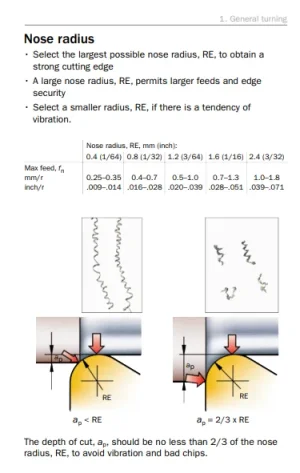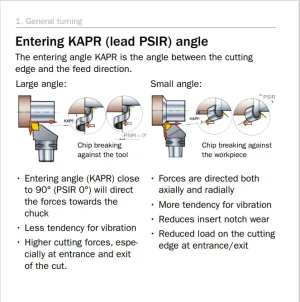@thestelster, try not to overthink this if you can. I overthink all the time and it kills me sometimes.
I know the brain sometimes needs to feel we are going by the book, but sometimes we need to throw the new books away and bring back the old ones....
Now where did I put my dam magnifying glass? The old books have such small letters...
The illustrations posted above are for optimum cutting conditions. It is very difficult to have every style insert, radius and holder at your disposal doing this as a hobby.
If you go by the book and illustrations above in order to find optimum cutting conditions for each part your machining in a hobby shop. You will be upside down on costs, along with piles of headaches trying to achieve the optimum cutting conditions in all types of materials.
Then you start thinking do I need a 90deg holder, 95 deg, 93 deg and so on.. looking for that optimum cutting condition.
Try not to let the " catalogue " mess you up.
Just know, when using indexable inserts, "especially nice new sharp ones..." be careful going into rads with them lol, plunge in with a nice used insert first it won't squack and chatter as much.
That's why I mentioned in the past, after roughing change the insert, after semi, change the insert but keep them aside for these types of applications.
Hobby guys, including myself, really need to stick to the basics when manual machining. Yes, indexable tooling is the way to go for roughing anything out quickly if your lathe can handle it.
Finishing with .012-.015 stock leftover is great for a diamond finishing insert with a .015r which I think is optimum for stock to leave on my manual lathe without chatter.
That may be too much for some and not enough for others depending on the part being turned with inserts they have on hand. My rads have been plunged out by this point for blending since I have so many different types of inserts to choose from.
Bottom line here is, if you only have 1 or 2 style of holders and inserts to choose from, along with say a button cutter,
your going to get some chatter. Your going to get an insert into a full diameter radius eventually, simply because its easier then grinding several different rads continuously on HSS and blanks if your turning contours and shaping. Most guys find it much easier to just plunge in and done, then blend or polish it out.
I find rule of thumb's do not apply so much in manual turning.
CNC, yes follow rule of thumb 'n' toe...
Speaking of " Rule of Thumb "
When turning with inserts. DavidR8 described it perfectly as mentioned above. If you have a .015 rad, take a minimum .015 DOC and so on.
I would say stick to insert rads that your lathe can handle in depths of cut. I can't say I follow the rules all the time thou..
Anyway, typing sucks on this end, I hope this shines some light on the illustrations with inserts.




